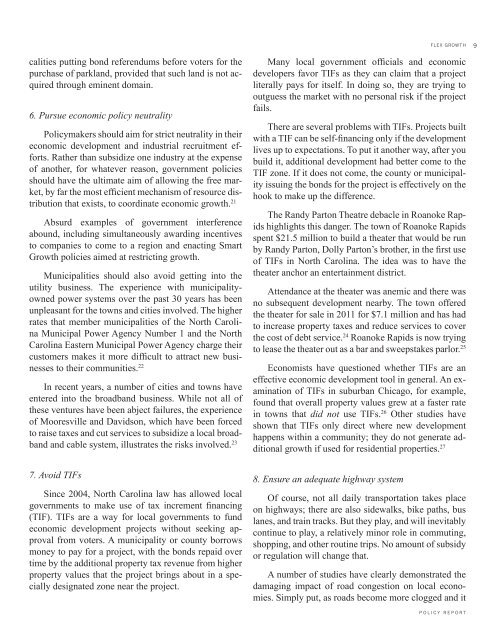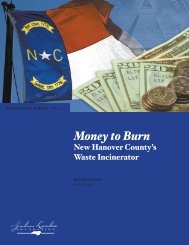Flex Growth - John Locke Foundation
Flex Growth - John Locke Foundation
Flex Growth - John Locke Foundation
You also want an ePaper? Increase the reach of your titles
YUMPU automatically turns print PDFs into web optimized ePapers that Google loves.
FLEX GROWTH<br />
9<br />
calities putting bond referendums before voters for the<br />
purchase of parkland, provided that such land is not acquired<br />
through eminent domain.<br />
6. Pursue economic policy neutrality<br />
Policymakers should aim for strict neutrality in their<br />
economic development and industrial recruitment efforts.<br />
Rather than subsidize one industry at the expense<br />
of another, for whatever reason, government policies<br />
should have the ultimate aim of allowing the free market,<br />
by far the most efficient mechanism of resource distribution<br />
that exists, to coordinate economic growth. 21<br />
Absurd examples of government interference<br />
abound, including simultaneously awarding incentives<br />
to companies to come to a region and enacting Smart<br />
<strong>Growth</strong> policies aimed at restricting growth.<br />
Municipalities should also avoid getting into the<br />
utility business. The experience with municipalityowned<br />
power systems over the past 30 years has been<br />
unpleasant for the towns and cities involved. The higher<br />
rates that member municipalities of the North Carolina<br />
Municipal Power Agency Number 1 and the North<br />
Carolina Eastern Municipal Power Agency charge their<br />
customers makes it more difficult to attract new businesses<br />
to their communities. 22<br />
In recent years, a number of cities and towns have<br />
entered into the broadband business. While not all of<br />
these ventures have been abject failures, the experience<br />
of Mooresville and Davidson, which have been forced<br />
to raise taxes and cut services to subsidize a local broadband<br />
and cable system, illustrates the risks involved. 23<br />
7. Avoid TIFs<br />
Since 2004, North Carolina law has allowed local<br />
governments to make use of tax increment financing<br />
(TIF). TIFs are a way for local governments to fund<br />
economic development projects without seeking approval<br />
from voters. A municipality or county borrows<br />
money to pay for a project, with the bonds repaid over<br />
time by the additional property tax revenue from higher<br />
property values that the project brings about in a specially<br />
designated zone near the project.<br />
Many local government officials and economic<br />
developers favor TIFs as they can claim that a project<br />
literally pays for itself. In doing so, they are trying to<br />
outguess the market with no personal risk if the project<br />
fails.<br />
There are several problems with TIFs. Projects built<br />
with a TIF can be self-financing only if the development<br />
lives up to expectations. To put it another way, after you<br />
build it, additional development had better come to the<br />
TIF zone. If it does not come, the county or municipality<br />
issuing the bonds for the project is effectively on the<br />
hook to make up the difference.<br />
The Randy Parton Theatre debacle in Roanoke Rapids<br />
highlights this danger. The town of Roanoke Rapids<br />
spent $21.5 million to build a theater that would be run<br />
by Randy Parton, Dolly Parton’s brother, in the first use<br />
of TIFs in North Carolina. The idea was to have the<br />
theater anchor an entertainment district.<br />
Attendance at the theater was anemic and there was<br />
no subsequent development nearby. The town offered<br />
the theater for sale in 2011 for $7.1 million and has had<br />
to increase property taxes and reduce services to cover<br />
the cost of debt service. 24 Roanoke Rapids is now trying<br />
to lease the theater out as a bar and sweepstakes parlor. 25<br />
Economists have questioned whether TIFs are an<br />
effective economic development tool in general. An examination<br />
of TIFs in suburban Chicago, for example,<br />
found that overall property values grew at a faster rate<br />
in towns that did not use TIFs. 26 Other studies have<br />
shown that TIFs only direct where new development<br />
happens within a community; they do not generate additional<br />
growth if used for residential properties. 27<br />
8. Ensure an adequate highway system<br />
Of course, not all daily transportation takes place<br />
on highways; there are also sidewalks, bike paths, bus<br />
lanes, and train tracks. But they play, and will inevitably<br />
continue to play, a relatively minor role in commuting,<br />
shopping, and other routine trips. No amount of subsidy<br />
or regulation will change that.<br />
A number of studies have clearly demonstrated the<br />
damaging impact of road congestion on local economies.<br />
Simply put, as roads become more clogged and it<br />
P O L I C Y R E P O R T










